Gamestop (GME) reports earnings Wednesday after the close. Options expiring this week are pricing about a 20% move in the stock. With the stock near $295 (at the time of writing) that translates to about $235 as a lower bound and $355 upper. From Options AI:
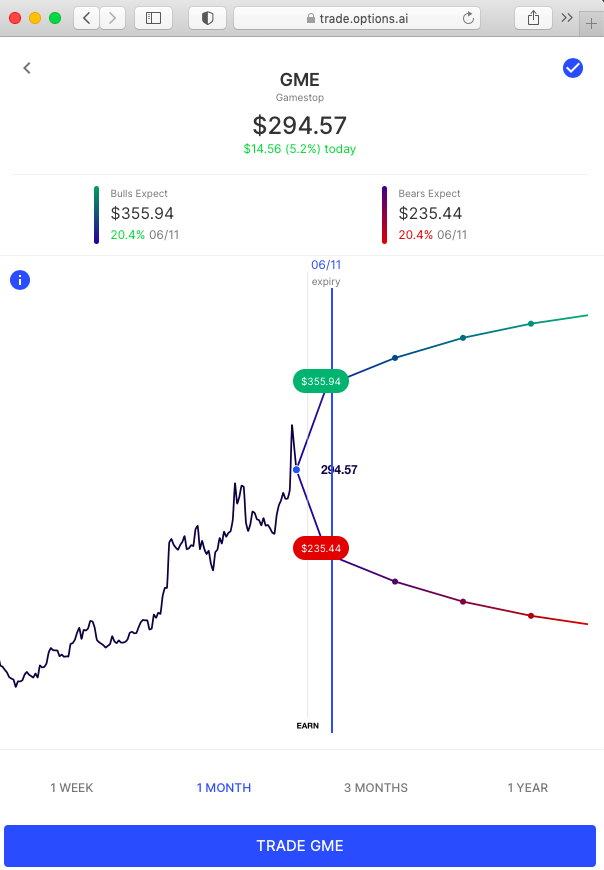
Whether an investor agrees with either the bullish or bearish consensus, or simply thinks the options market is under or over-pricing the move altogether, knowing the expected move can serve as a useful gut-check before any major catalyst event. The expected move is an actionable way of viewing implied volatility, and how much a stock needs to move for options to be in the money or out of the money.
Typically, a catalyst event like earnings will see a ramp higher in implied volatility (and therefore the expected move) into the event and a steep decline in implied volatility after the event. But with meme/short squeeze stocks being so volatile from day to day, options must price those everyday moves as well. For instance, the 20% expected move that includes today’s earnings must factor in that GME was already higher by more than 20% today, even before earnings are reported after the close.
The meme stocks tend to see increasing implied volatility as they rise, with implied volatility falling when the stocks themselves fall. In other words, when the stocks are squeezing higher, more movement is expected than when they are not squeezing. Additionally, the meme stock options have high levels of skew, especially to the upside. This is due to retail demand for far out-of-the-money calls. Skew means that out-of-the-money calls trade at much higher implied volatility than near or at-the-money calls.
For comparison, here are the expected moves for AMC (no earnings event) vs GME (earnings Wednesday)
- AMC: 22%
- GME: 20%
Options AI puts the expected move at the center of its options trading experience, allowing traders to compare debit and credit spreads to outright calls or stock in a few clicks.
Below, we’ll explore further how the expected move, skew, and swings in implied volatility can be considered in trade strategies. Particularly in helping guide strike selection in strategies that seek to reduce costs at a time of elevated volatility.
Alternatives to Stock (or Calls)
At the time of writing, buying 100 shares of GME stock would cost over $30k. Buying a weekly $310 (at-the-money) Call (100 share equivalent) costs around $36, or $3600 in premium. In order for the call to be profitable on Friday’s expiration, the stock would need to be above $346.
Now, let’s take a scenario where a trader generally agrees with the 21% expected move and uses that move to guide strike selection when creating a defined risk option spread.
Using the Options AI platform, we’ll look below at some alternative strategies that have been generated with the expected move guiding strike selection.
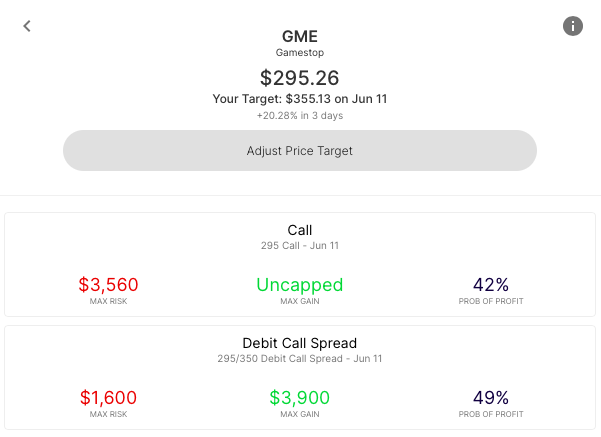
The Debit Call Spread lowers the cost of buying the at-the-money call (295) by simultaneously selling a Call around the expected move level (350). The Debit Call Spread, costs around $16… $20 less than the $36 for the 295 call outright. That brings the break-even level of the trade to around $311, compared to $331. The trader has also reduced their overall exposure to elevated volatility in the options versus an outright call. Less capital is at risk, and a lesser move higher is needed in order to at least breakeven.
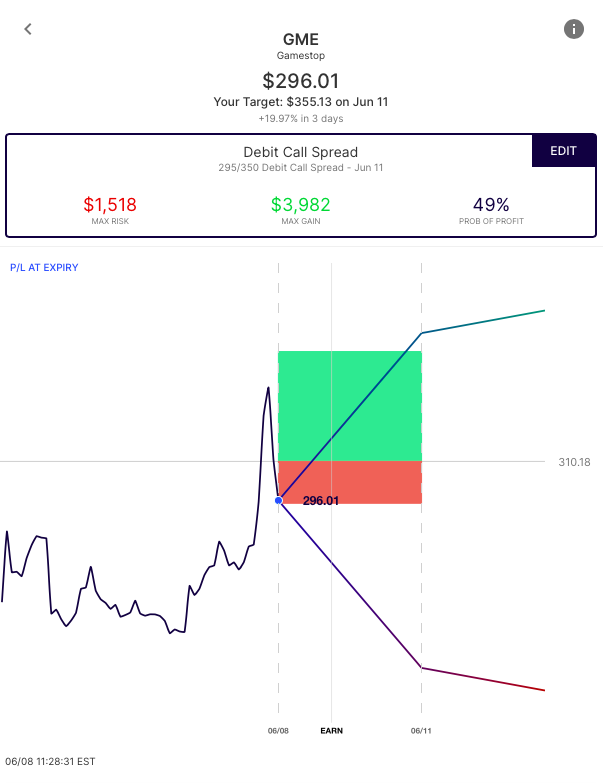
Aside from the additional potential risks of option spreads (such as early assignment and liquidity), it is important to note that a spread caps potential profits (if the stock moves beyond $350). One way of looking at this is that the trader has joined the option market consensus and is therefore willing to cap gains at that point in exchange for a lower breakeven and a higher probability of profit.
Skew is a big factor in debit call spreads. This particular debit call spread is selling the $350 call at around $19, that sale is more than the cost of the spread itself. In other words, a trader can pay less for a move to the upper strike of this trade, than those buying that 350 out-of-the-money strike outright. Those buying that call need a move beyond $369… far beyond what options are pricing. That demand for out-of-the money calls creates skew, which in turn benefits debit call spread prices compared to outright calls.
Alternatives to Puts
If a trader is interested in positioning for a move lower in the stock, the bearish consensus can serve as a guide. Again, using the Options AI platform, with a June 11th expiry we can see a put spread to the lower expected move, compared to an at-the-money put outright:
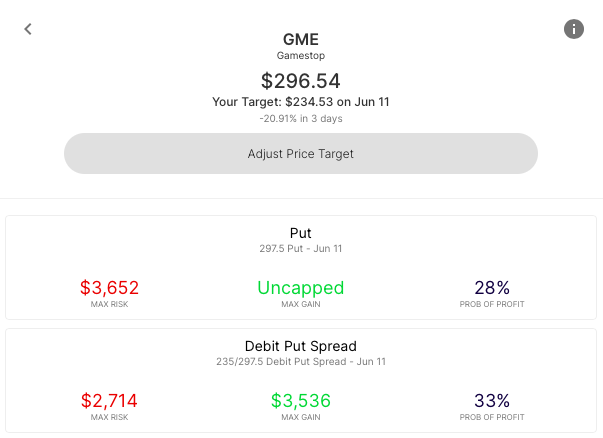
Skew exists to the downside as well, but less pronounced. But as mentioned above volatility often falls when the short squeeze/meme stocks go lower. It is not uncommon for out-of-the-money puts to have lost value on days when a meme stock like GME is lower. A debit put spread lessens that volatility risk vs outright put buys.
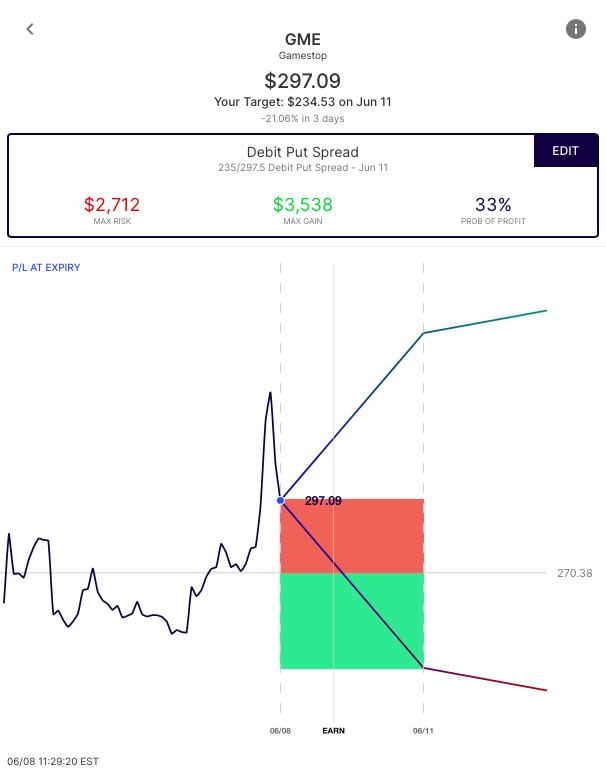
Using a Price Target for Hedging
Options AI can also generate trades based upon a user’s price target. In this example, we’ll assume a trader is long shares of GME and wants to protect against an outsized move to the downside. A price target might be placed down 35% in the stock, nearly twice the move options are expecting – a move that someone who is long the stock may be willing to pay money to protect against:
.2021-06-08%2009_34_07.gif)
The 235/190 debit put spread is simply an example. It costs about $700 but would protect shares from around $228 down to $190. In this case the trader has used a target to hedge against a scenario where the options market gets it wrong.
Options AI provides a couple of free tools like an expected move calculator, as well as an earnings calendar with expected moves. More education on expected moves and spread trading can be found at Learn / Options AI.
Based upon publicly available information derived from option prices at the time of publishing. Intended for informational and educational purposes only and is not any form of recommendation of a particular security, strategy or to open a brokerage account. Options price data and past performance data should not be construed as being indicative of future results and do not guarantee future results or returns. Options involve risk, including exposing investors to potentially significant losses and are therefore not suitable for all investors. Option spreads involve additional risks that should be fully understood prior to investing. Securities trading is offered through Options AI Financial, LLC a registered broker-dealer.


